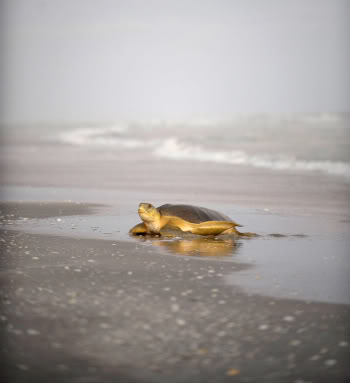Beginning today in Brisbane, Australia, the 29th annual Symposium on Sea Turtle Biology and Conservation will feature the flatback sea turtle, native to Australia and probably the least-studied of the marine turtle species.
For a hundred years biologists debated as to how closely the flatback marine turtle was related to the green sea turtle. Several unique attributes of the flatback came to the forefront. The name ‘flatback’ describes the turtle’s distinct flattened carapace. The species also lays the largest eggs of any sea turtles, proportional to their size. However, perhaps most distinctly the flatback is the only marine turtle to call one nation home. The flatback forages, mates, and lays eggs along Australia’s coats; its penchant for swimming, rather than riding oceanic currents, keeps it from migrating across oceans as other turtle do.
 Flatback sea turtle being weighed by researchers.Photo by: Calen Offield. |
By 1988 Dr. Col Limpus, President of the International Sea Turtle Society (ISTS), determined that the flatback was unique enough to be forever separated from the green marine turtle, and the flatback gained its own genus. Despite its new standing, the flatback remains mysterious.
Flatback marine turtles have been difficult to study since they share much of their habitat with saltwater crocodiles. The world’s largest reptile not only preys on the marine turtle, but also poses great danger and difficulty to any researcher brave enough to study the turtle.
Listed as vulnerable by the Australian government, the flatback is threatened by a number of commercial fishing-related activities: gill nets left out to catch sharks, long line fishing that catches individual turtles on lines and drown them, and so-called ‘ghost-nets’. These are massive discarded nets that are known to entangle the turtles. Some of the nets have been measured at an astounding 55 miles across.
 Flatback sea turtle. Photo by: Calen Offield. |
Threats not only affect adult flatbacks. Newly-hatched flatbacks, like all species of marine turtles, are sensitive to degradation of nesting sites and light pollution. Instinctively baby turtles move toward the brightest object in the landscape after hatching, which in nature is the ocean. Artificial light confuses infant turtles, steering them in the wrong direction and sometimes leading to massive mortalities.
In addition, dogs, pigs and goannas—Australian monitor lizards—often dig up nests. In one nesting area, pigs were recorded digging up 90 percent of the nests.
“Sea turtles are threatened by climate change, environmental degradation, and human activities throughout much of the world,” Limpus says. “Understanding and effectively managing and protecting their populations is critical to the long term survival of these magnificent creatures.”
The symposium aims to mitigate these threats by bringing scientists, wildlife managers, and policy makers together to discuss the most up-to-date information on conservation and research of marine turtles.
Despite the attention to all of the world’s marine turtles, the star of this year’s symposium is likely to be Australia’s very own flatback.
Saving leatherback turtles in South America’s smallest country, Suriname: An interview with Liz McHuron
(01/27/2009)
After a semester studying marine biology at Moss Landing Marine Labs, Liz McHuron headed off to the little-known nation of Suriname to monitor leatherback sea turtles. Her responsibilities included implementing a conservation strategy for a particular beach, moving leatherback nests in danger of flooding, and educating volunteer workers on the biology, behavior, and conservation efforts of the world’s largest, and most unique, marine turtle.
“Turtle carbon” could help protect rainforests and save endangered sea turtles
(08/12/2008)
Using carbon credits to promote rainforest conservation could help protect endangered sea turtles in some parts of the world, argues a carbon finance expert.
86% of sea turtle species threatened with extinction
Turtle conservation is like its namesake:
it’s slow, but there are big rewards
(11/14/2007)
Marine turtles have thrived for more than 100 million years. But only the last few hundred years have given the huge, spectacular, prehistoric reptiles serious trouble.